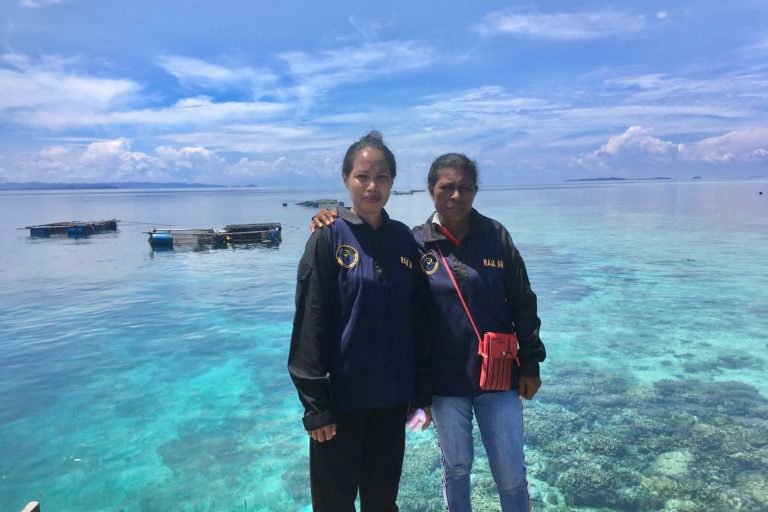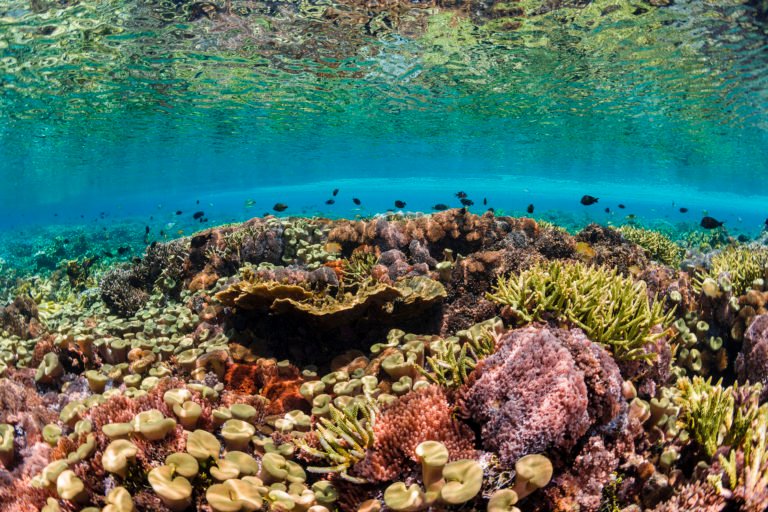- Of the 147 birds — mainly Guanay cormorants, Peruvian boobies and Humboldt penguins — rescued from an oil spill off Lima and brought to the city’s Parque de las Leyendas zoo for treatment, only 79 have survived.
- Mongabay Latam joined officials from SERNANP, Peru’s protected areas agency, as they scoured the oil-hit area around the Guano Islands, Islets and Capes National Reserve System to record the number of affected animals, dead and alive.
- The Jan. 15 spill resulted in 11,900 barrels of oil pouring into the sea, with the company responsible, Spain’s Repsol, reportedly failing to take containment measures immediately.
- The spill has also devastated local fishers, who until then had been recognized by the Peruvian government for their environmentally responsible fishing practices.
It’s Jan. 29, two weeks after an oil spill off Pocitos Beach in the Ancón protected area, and one’s eyes and skin still burn when walking near the oil-blackened rocks. Like a pasty mud, the oil still covers stones along the shore and seeps everywhere with each wave.
Hundreds of people in white overalls, hired by Spanish oil major Repsol to clean Pocitos and other beaches affected by the Jan. 15 spill, shovel away oil-contaminated sand and place absorbent pads in the water, trying to remove as much of the 11,900 barrels of crude oil that spilled. That’s according to the most recent report from the Ministry of the Environment. But officials from SERNANP, the national agency for protected areas, who have been monitoring the impact of the disaster in the protected area since Jan. 16, the day after the spill, say the company responded late.
“As of [Jan. 17], no one from the company was here,” said Deyvis Huamán, head of SERNANP’s monitoring, surveillance and control unit. The cleanup activity taking place on Jan. 29 had been under way for “barely a couple of days,” Huamán told Mongabay Latam during a tour of the beach. This was corroborated by officials from SERFOR, the national forestry and wildlife agency.
The spill was a freak incident that observers say should never have been allowed to happen: it occurred as oil was being pumped out of an oil tanker and into Repsol’s La Pampilla refinery during unusually high waves. Those waves were generated by the Tonga volcanic eruption and ensuing tsunami some 10,000 kilometers (6,200 miles) across the Pacific.
Fifty minutes offshore, around Los Pescadores Island, part of the Guano Islands, Islets and Capes National Reserve System, fisherman Abelino Ramírez can see containment barriers being installed. It’s the first time since the spill began that he’s seen these floats, which are meant to prevent the oil slick from reaching the rocks where thousands of birds gather and onto which sunstars and starfish attach themselves, and where snails, octopuses, fish and mollusks shelter.
“Yesterday they weren’t there,” he says as he steers his boat toward the island, where the polluted waves crash against the rocks, now crowned with a yellow foam — a clear sign that the installed barriers arrived too late.
Ramírez, better known as Mayumi, normally takes tourists out for a ride on his boat, an activity that he alternates with fishing. Today, unable to carry out either of his two jobs, he transports SERNANP scientists to record the number of animals both killed and stained by the oil, and to try to save the lives of drifting birds that are unable to fly.
The plan was to visit most of the islands that are grouped in front of Ancón Bay, but this wasn’t possible. In the afternoon, Ramírez traveled to Los Pescadores Island, picking up any lifeless birds floating in the sea.
Dead and dying birds
There aren’t enough black bags for the dead animals’ bodies; the SERNANP officials only brought 10 bags with them, which would be enough during any of their routine visits to the Guano Islands, Islets and Capes National Reserve System to carry out a population count. This time, they’ve found nearly double the number of dead Guanay cormorants (Leucocarbo bougainvilliorum) and Peruvian boobies (Sula variegata); SERNANP veterinarian Giancarlo Inga Díaz puts their bodies into the plastic bags four at a time.
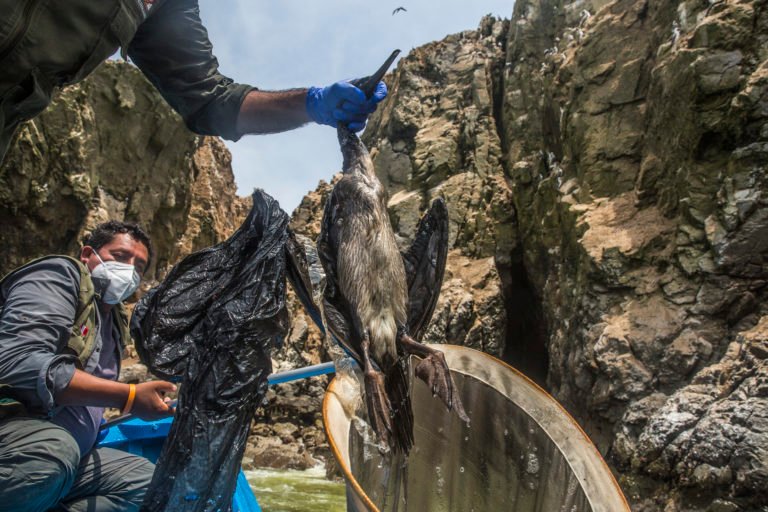
“They are the most vulnerable species,” says Roberto Gutiérrez, a specialist with SERNANP. To hunt their prey, both cormorants and boobies dive into the sea like an arrow launched at full speed; between these dives, they hover over the water. According to Gutiérrez, this behavior makes it more likely that they’ll come into contact with the contaminated water. When that happens, their body gets covered with oil (either in a single instance or gradually), until they can no longer open their wings and become stranded, floating in the sea and unable to take flight.
This ultimately results in their death due to starvation or hypothermia, as the contaminated water causes the birds’ feathers to lose its waterproofing; their bodies become wet on contact with the water, then cools down. The exact opposite of this can happen to the birds if they remain on land rather than in the water: “In the sun, the layer of oil begins to heat up,” Díaz says, adding this can also lead to the animals’ death.
In the space of just a few hours, SERNANP officials collect 16 cormorants and two boobies — all dead and all of which had oil on their bodies and inside their beaks, indicating that “they died from the spill,” Huamán says. They find three other birds alive, one of which dies shortly after rescue aboard the ship. One of the others, covered in a pasty black layer with burn injuries around its eyes from the oil and its beak open wide as if gasping for air (a sign of stress, according to experts), remains almost motionless in the box that holds it while on the way back to the beach.
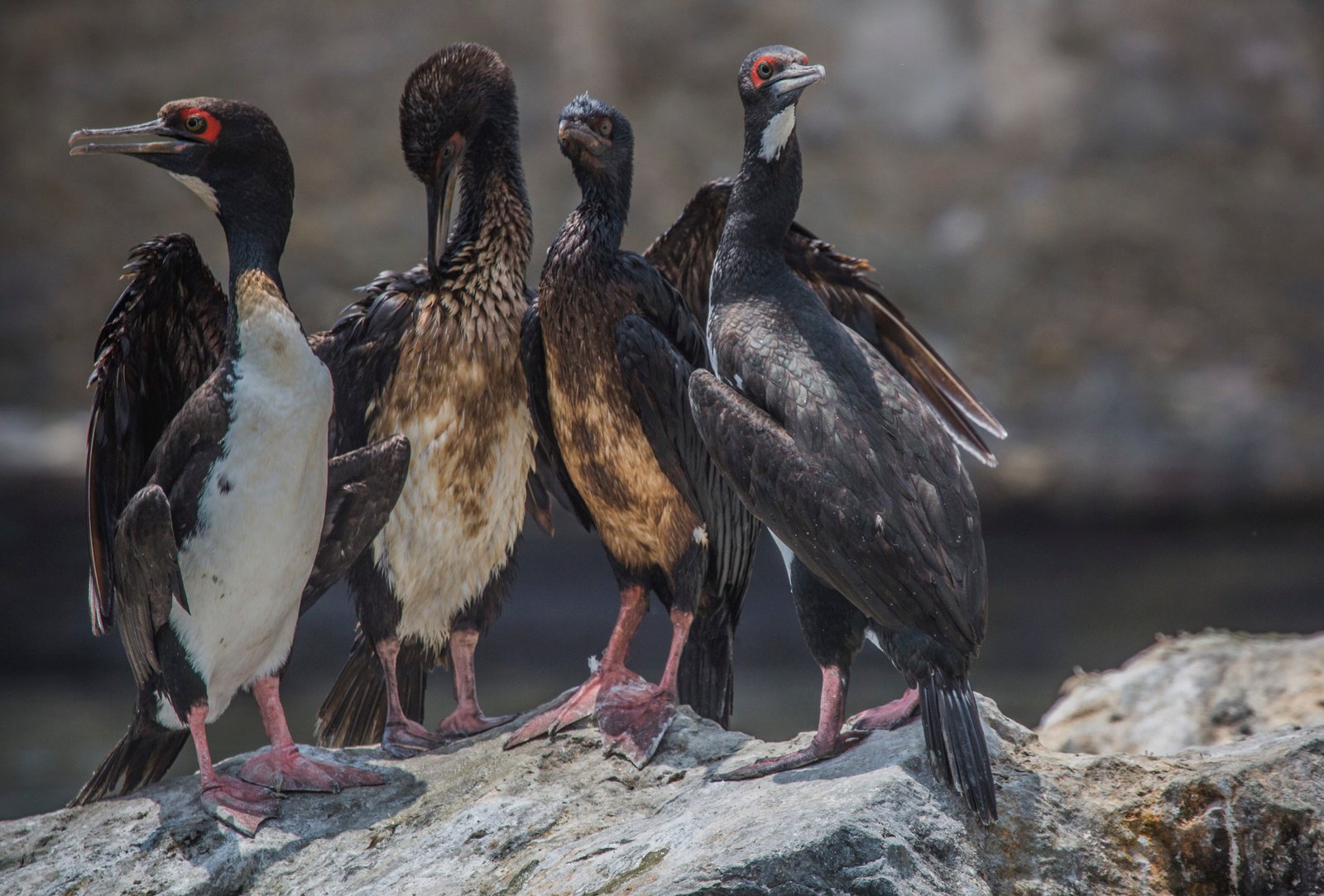
The surviving birds are headed to Parque de las Leyendas, a zoo in Lima that’s working with SERFOR to rehabilitate the birds so that they can be released back into the wild. So far, 147 birds of 10 different species, mainly Guanay cormorants, Peruvian boobies and Humboldt penguins (Spheniscus humboldti) have made it to the zoo; however, the effects of poisoning, starvation and dehydration have killed many, with just 79 currently alive.
The birds don’t get cleaned up until four or five days after arrival. First, they have to be checked over by a team of veterinarians formed to assist the emergency, who determine their exact state of health through weighing them and measuring their temperature as part of a protocol.
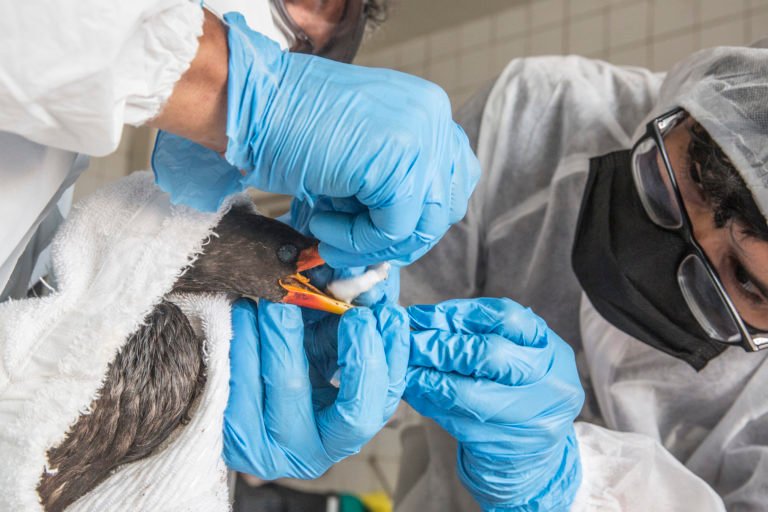
While checking a cormorant to determine the extent of damage to its waterproof layer, Luis Delgado, a veterinarian from Ricardo Palma University, says the normal body temperature for these birds is 40-41° Celsius (104-106° Fahrenheit). But many arrive with temperatures of 36-37°C (97-99°F). Having wet plumage not only cools the birds’ bodies, but also prevents them from searching for food, meaning they arrive weak and even in a state of starvation.
The next stage is to stabilize the birds, which are fed and sheltered to help them regain their weight and temperature. Once this has been achieved, the birds are then moved to the third step in the process: cleaning.
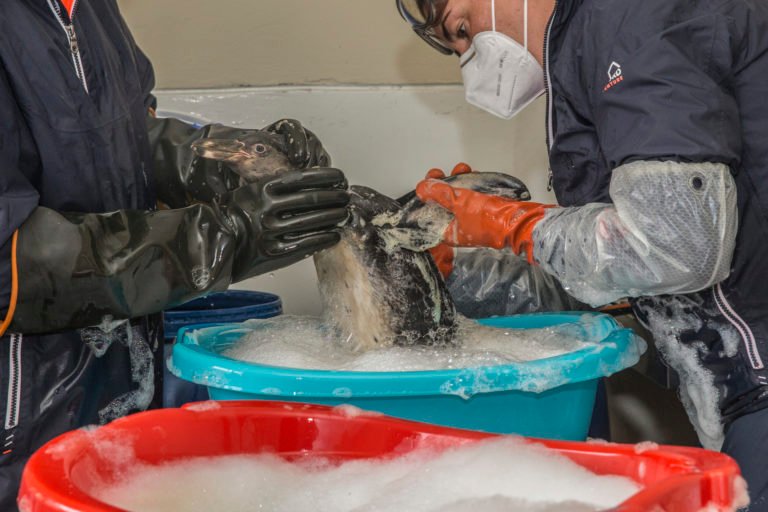
At the zoo, a pair of vets bathe a penguin with pressurized water. “It is not a soft bath. It is quite forceful and must be that way because otherwise the oil will not come out,” says Lizette Bermúdez, the general coordinator of the rescue. They bathe the penguin for about 30 minutes, turning it every which way and lifting its wings to clean every part of its body. Although the penguin seems resigned to the activity and somewhat calm, this isn’t the case. “When you subject the animals to cleaning, they get very stressed,” Bermúdez says — to the extent that “it could even cause death.” This is why the previous stage of stabilization is essential, as it allows the animals to recover the strength necessary to face the bathing.
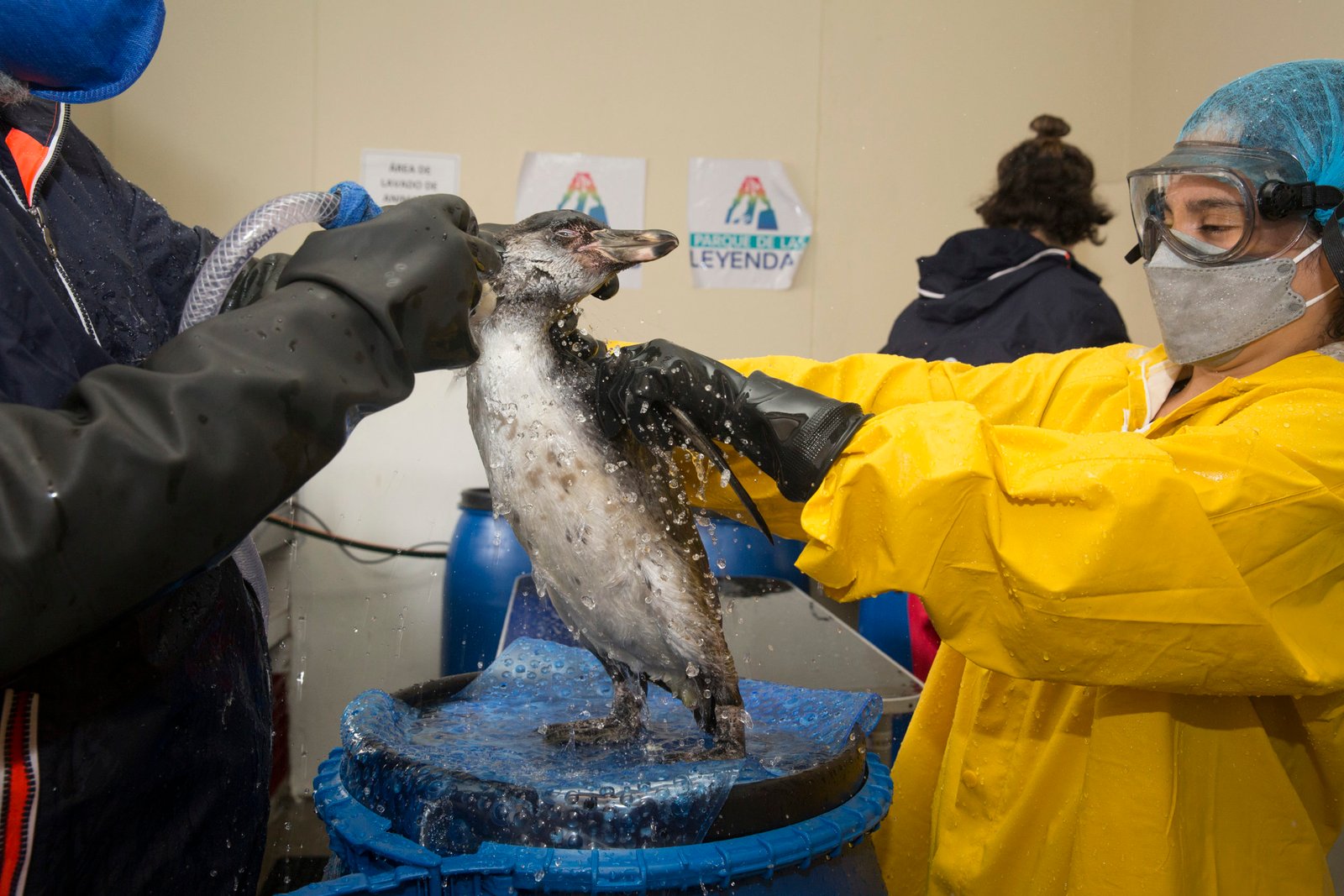
This is also why the specialists have appealed to volunteers not to wash the animals when they rescue them, as it can be counterproductive. “Birds have already arrived here that have been bathed, and they are much weaker for it. The procedure must be done by a specialist,” one of the vets says.
The subsequent rehabilitation process can last several months, depending on the state of health of each bird, and rewilding can take even longer. Where the birds will be released following their rehabilitation is something that must be evaluated to prevent them from further contact with the contaminated sites.
To strengthen their efforts, the team of vets at Parque de las Leyendas receives donations of biosafety equipment (suits, masks, goggles, gloves), boots, cages, tubs and trays, plastic containers for hazardous waste, toothbrushes, and saline solution.
A lost conservation job
Like other fishers operating in the Guano Islands, Islets and Capes National Reserve System, Abelino Ramírez was under strict self-imposed restrictions to conserve the marine species he targeted: no more than 50 kilograms (110 pounds) of octopus and eight dozen snails per boat.
Further fishing restrictions included the closure of some of the islands for a period of time, a measure that started in 2015 to allow the recovery of some species. Following the first closures of one of the islands, which lasted more than a year, the snails he caught were larger and the octopuses heavier, Ramírez says, indicating that the strategy had worked. As a result, the fishers continued to place temporary bans or closures and post guards to ensure compliance.
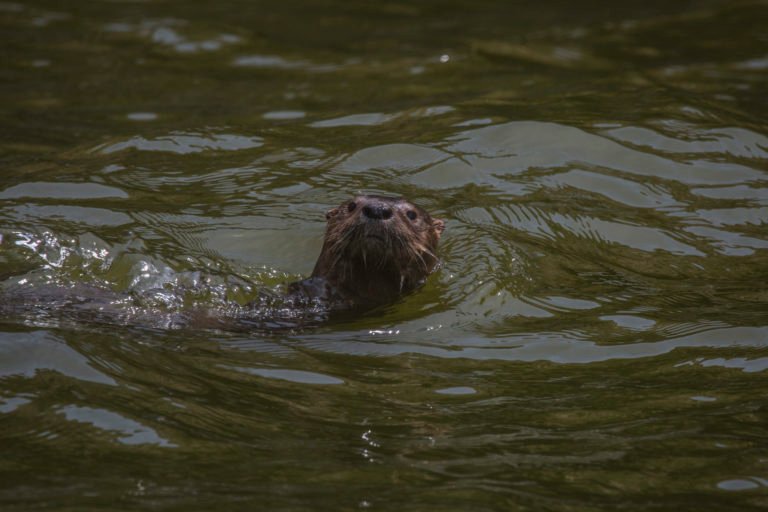
In June 2021, Peru’s environment minister at the time, Gabriel Quijandría, appointed the Association of Artisanal Fishers of Ancón as ambassadors for the national initiative “Peruanos Naturalmente,” citing their commitment to conserving the marine ecosystem. “They have been moving in the right direction toward a greener, fairer and more sustainable world,” Quijandría said. (Quijandría left office in July, with the rest of the administration of Francisco Sagasti, upon the inauguration of Peru’s newly elected president, Pedro Castillo.)
Now, Ramírez, with his round face and large nose, narrows his eyes at the oil-stained plumage of the birds that squawk on the rocks, as SERNANP specialists continue to collect the inert bodies from the foamy water with a butterfly net. He says he’s certain that “much more” than 6,000 barrels spilled into the sea, asserting so four days before the Ministry of the Environment confirmed that it was in fact nearly double that: 11,900 barrels.
“I have no words to express my frustration. So many years’ work has gone to waste,” Ramírez says, adding, “How could a transnational company, with all the advances made in science and technology, not be able to make a good contingency plan? For us, it’s as if the sky has fallen on us.”
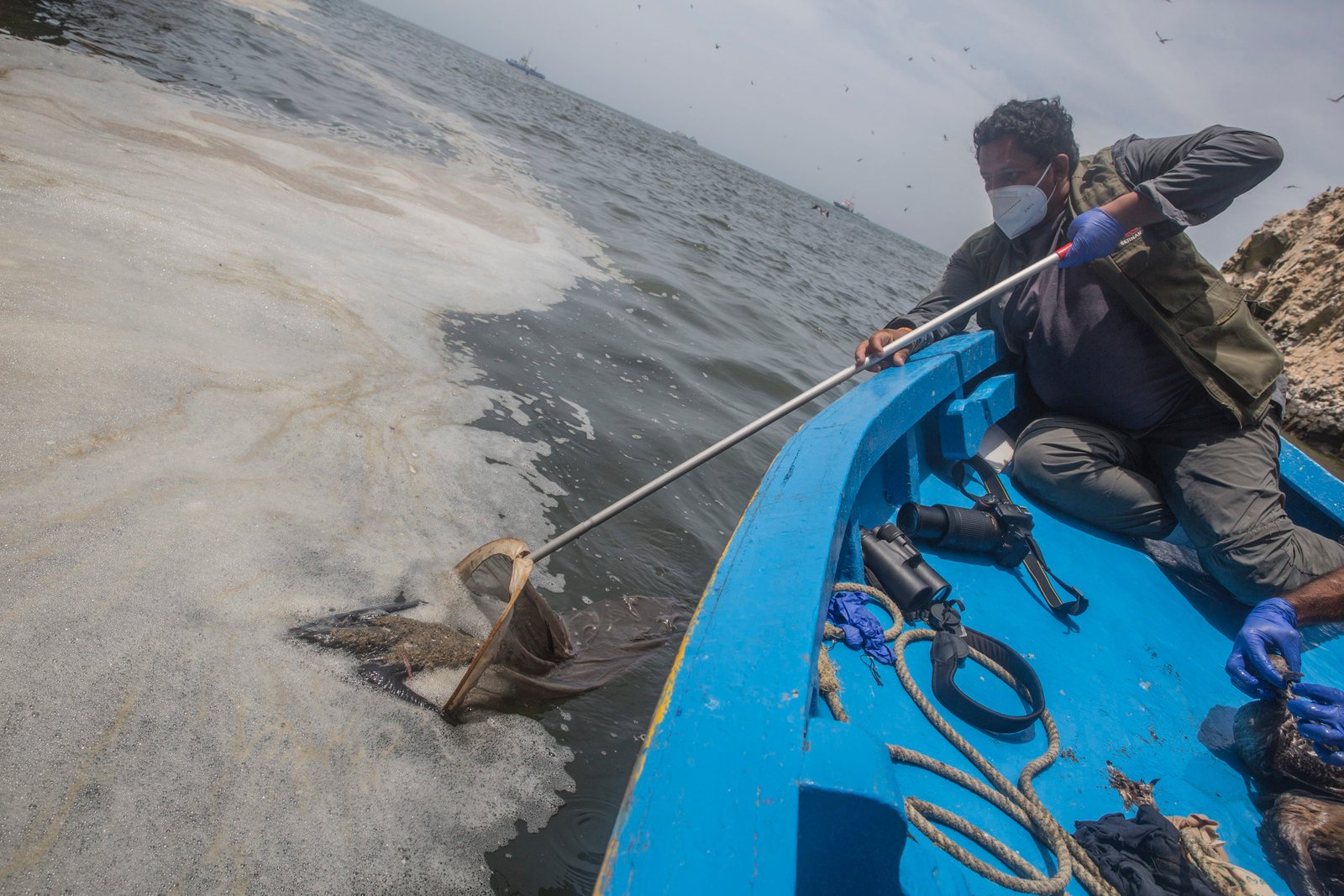
Suddenly, an otter that looks to be healthy appears on the rocks. The scientists and fishers alike brighten up as the animal cleans its face with its hands. It dives and swims nimbly. This is good news in the desolate landscape, as the sea otter (Lontra felina), or sea cat as the fishers call it, is an endangered species that’s also one of the most vulnerable to the effects of an oil spill.
“They have not been able to withstand the spill,” says Pilar Ayala, a wildlife specialist with SERFOR, adding this is why no otters have been rescued alive yet and taken to Parque de las Leyendas.
“In Santa Rosa, in the Playa Chica resort, there was a family of four otters living there years ago, but they all died,” says Arturo Bullón, the SERFOR specialist who receives the rescued birds.
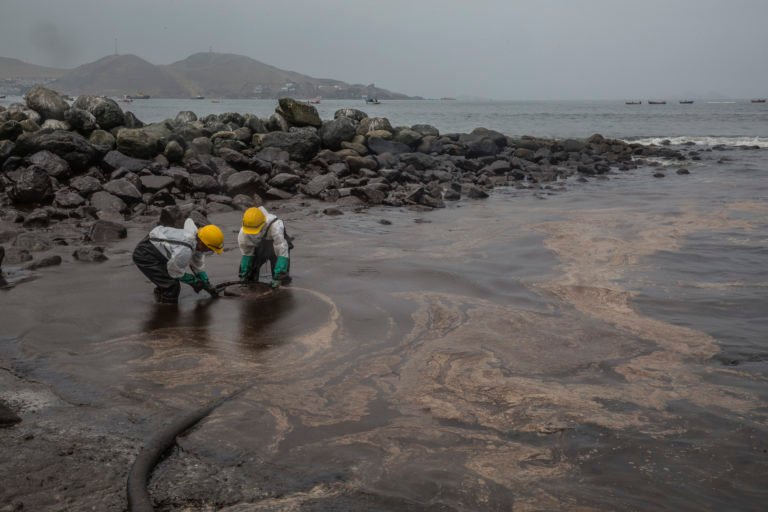
The number of dead cormorants and boobies that the officials have collected on this day, Jan. 29, is higher than on any other day since the Jan. 15 oil spill. For the SERNANP specialists, it confirms their fears that they will “continue to find more because the birds that have been contaminated are going to die over the course of each day,” Huamán says.
The information recorded will be provided to the prosecutor’s office to be considered in the ongoing investigations against Repsol for environmental damages. However, according to the SERNANP specialists, the final number given in these records will be an underestimate of the true death toll among the wildlife.
“Penguins usually walk toward the island’s interior, which is why we find fewer, but it does not mean that there are no dead individuals,” Gutiérrez says.
Likewise, it’s not just the oil-contaminated birds or those that have eaten contaminated food that will suffer, but also the thousands of chicks that are waiting to be fed by their parents on the national reserve’s islands, many of which will not survive.
Banner image of SERNANP officers rescuing birds by Max Cabello Orcasitas/Mongabay Latam.
This story was reported by Mongabay’s Latam team and first published here on our Latam site on Jan. 29, 2022.




